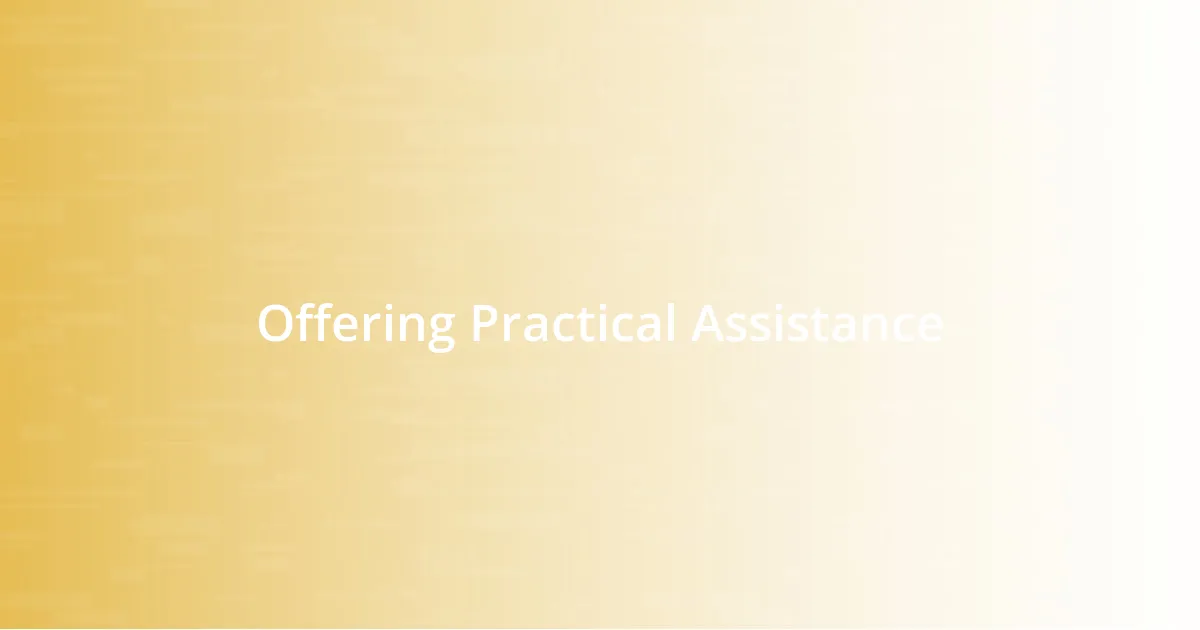Key takeaways:
- Support plays a crucial role in helping individuals navigate challenges, emphasizing the importance of empathy and active listening over mere advice-giving.
- Identifying signs of friends in need, such as behavioral changes and emotional cues, allows for deeper engagement and invaluable support.
- Offering practical assistance, like accompanying friends to events or tackling chores together, can significantly alleviate stress and foster connection.
- Regular follow-ups and sharing resources encourage ongoing support and help create a collaborative environment for personal growth among friends.

Understanding the Importance of Support
Support can make a remarkable difference in someone’s life, especially during challenging times. I remember when a close friend faced a difficult decision about their health. I offered a listening ear, and that simple act allowed them to process their feelings, ultimately empowering them to make a decision that was right for them. Isn’t it incredible how just being there for someone can create a safe space for them to navigate their struggles?
When we think about support, I often reflect on the ripple effect it creates. One person’s strength can uplift many, and I’ve seen this play out in my own circle of friends. For instance, by sharing resources and ideas on healthy living with a buddy, I noticed they began to adopt better habits, which encouraged others around them to join in as well. What does it say about our human connection when a simple act of support can inspire a whole community?
It’s crucial to recognize that support isn’t just about offering advice; it’s about empathy and understanding. I vividly recall a time when I reached out to another friend who was struggling with their mental health. Instead of jumping in with solutions, I made it a point to validate their feelings first. How often do we prioritize connection over corrective measures in our relationships? The impact of that moment resonated with both of us and echoed the sentiment that being there is sometimes far more valuable than having the answers.

Identifying Friends in Need
Identifying friends in need can sometimes be as subtle as noticing a change in their behavior. When I think back to a time when a close friend started isolating themselves, it struck me how important it was to pay attention to those small cues. I offered casual invites to hang out, and while they often declined, I made sure to check in regularly. That persistence allowed them to feel supported even in their toughest moments.
It’s not just about what they say, but how they say it. I recall a friend who usually had a bright demeanor but suddenly seemed reserved. Her laughter was less frequent, and her text responses felt different—shorter and more detached. I remember asking her about it directly and being surprised by how simple that question was. It opened up a door for her to share what was really going on beneath the surface. Can you think of moments where you sensed something was off with a friend? It’s those instincts we often overlook that can be the key to helping someone navigate through their struggles.
Some friends show their need for support in indirect ways, and it can help to engage with them more deeply. For instance, one day I discussed our plans and noticed my friend hesitate when I mentioned a social event they used to love attending. Instead of brushing it off, I gently encouraged them to share their feelings about it. This not only brought to light their hidden struggles, but it also created an opportunity for connection, making them feel heard. What I’ve learned is that simply engaging in deeper conversations can illuminate what’s really happening in someone’s life, ultimately allowing me to offer better support.
| Signs of Friends in Need | Examples |
|---|---|
| Behavior Changes | Withdrawing from social interactions |
| Emotional Cues | Shorter or distant responses in conversations |
| Indirect Signals | Hesitation or discomfort when discussing activities they once enjoyed |

Listening Actively to Concerns
Active listening transforms a conversation from simply hearing words to truly understanding feelings. I remember a specific moment with a friend who was anxious about a job interview. Instead of rushing to give advice, I focused on her thoughts and emotions. I made a conscious effort to listen without interrupting—creating a space for her to express herself fully. It was enlightening to see how that made her feel validated and allowed her to articulate her fears openly.
Engaging with someone’s concerns requires more than just passive listening; it means fully investing in the dialogue. During a time when a friend confided in me about feeling overwhelmed, I practiced active listening by reflecting back what she said. This technique, where you paraphrase or summarize a person’s words, can clarify their emotions and deep-seated worries. Here’s a quick rundown of ways to show active listening:
- Maintain eye contact: This shows that you are genuinely engaged and interested.
- Ask open-ended questions: These encourage deeper exploration of their feelings.
- Nod and give verbal affirmations: Simple gestures like “I see” or “That makes sense” help convey that you’re present in the moment.
- Reflect emotions: Acknowledge what they’re feeling by saying things like “It sounds like you’re really stressed about this.”
- Avoid distractions: Put your phone down or find a quiet place so you can focus entirely on the conversation.
Being an active listener not only supports your friends but also fosters a connection that encourages them to open up even more. I think the act of listening can be a powerful tool in bridging emotional gaps and providing the reassurance that friends often need.

Offering Practical Assistance
Offering practical assistance to friends in need can take many forms, and it often goes beyond what you might initially consider. I remember a time when a dear friend was struggling with household tasks due to overwhelming stress. I decided to show up one Saturday, armed with cleaning supplies, and simply tackled a few chores together. That unexpected help not only lightened her load but also provided a much-needed distraction. Have you ever thought how a little bit of assistance like this can transform someone’s day?
When I think about practical support, it’s also about being there during crucial moments. For instance, I once noticed a friend was hesitant about attending an important event. Instead of encouraging him to go alone, I offered to accompany him. Knowing he had someone by his side made a world of difference; we talked and shared laughs on the way, easing his anxiety. This experience taught me that even the simplest gestures, like being a physical presence, can convey immense support.
It’s crucial to recognize that practical assistance isn’t just about physical tasks; it also encompasses emotional support. On another occasion, a friend was going through a tough breakup, and I offered to cook dinner and have a movie night. Creating a safe, comfortable space allowed her to open up about her feelings without the pressure of performing in social settings. How often do we underestimate the power of simply being there, sharing our time, and providing comfort? By offering thoughtful assistance, we can foster healing and connection during difficult times.

Encouraging Healthy Habits
Encouraging healthy habits in friends is a journey that I truly enjoy being a part of. One sunny afternoon, I decided to invite a friend for a hike in the nearby hills. Initially hesitant, she eventually agreed, and I could see how the fresh air and physical activity lifted her spirits. That day not only strengthened our bond but also sparked her interest in regular outdoor activities—sometimes, all it takes is a gentle nudge into a world of scent, color, and motion.
Moreover, I’ve found that sharing resources can be a great way to promote healthy habits. I once came across a fantastic meal prep guide that emphasized balanced eating. Instead of keeping it to myself, I mentioned it during our next coffee catch-up. The excitement in her eyes as we planned to cook together that weekend was infectious. Isn’t it amazing how a shared goal can turn into an opportunity for connection and support?
Another effective tactic I’ve embraced is leading by example. When I started my journey of yoga practice, my friends became curious about how it impacted my overall well-being. I invited them to join me for a class, and the playful atmosphere finally eased their initial hesitance. Isn’t it fascinating how encouraging a healthy habit can turn into a shared experience, creating lasting memories while promoting wellness? That interplay of influence and support really cultivates a healthier lifestyle for everyone involved.

Sharing Resources and Information
When it comes to sharing resources and information, I find it can truly empower my friends. Recently, I stumbled upon a great mental health app that tracks moods and offers daily tips for wellness. I remember excitedly sharing it with a friend who was feeling a bit lost. Seeing her eyes light up at the prospect of having a tool to help her navigate tough days reminded me how valuable knowledge can be in making a difference in someone’s life.
Another instance that stands out to me is when I came across a workshop on stress management techniques. Knowing a couple of friends were dealing with work-related stress, I sent them a quick message about it. The energy in our group chat shifted immediately, as they expressed gratitude and curiosity. It was a reminder that sometimes, simply passing along information can spark not only awareness but also a sense of possibility. Have you ever noticed how sharing resources can foster a sense of community and support among friends?
I’ve also learned that being proactive about sharing information is essential. During a casual dinner with friends, we ended up discussing healthy eating habits, and I shared a useful cookbook that transformed my approach to meals. The way everyone perked up and began exchanging recipe ideas reminded me that sharing doesn’t just stop at resources—it can ignite creativity and inspire us to try new things together. Isn’t it fascinating how a simple conversation can evolve into a collaborative effort toward better choices?

Following Up and Checking In
Following up with friends is an essential part of supporting their journey. I remember reaching out to a friend after a particularly tough week she faced. Just a simple message asking how she was doing made her share what was on her mind, and I was surprised at how much lighter she felt after talking it through. Isn’t it amazing how just checking in can open up a conversation that leads to healing and connection?
I also find that consistent check-ins can help establish a rhythm of support. After encouraging a friend to explore meditation, I made it a point to ask her how she was experiencing it a few weeks later. That prompted her to reflect on her progress and even share some unexpected insights about her journey. It feels rewarding to be that person who isn’t just a passive listener but actively engaged in their growth, don’t you think?
Additionally, I think it’s important to approach these follow-ups with genuine curiosity. A while ago, I decided to turn our weekly catch-up into a space for sharing our current wellness goals. My friend opened up about wanting to reduce screen time, and together we brainstormed fun alternatives. Those moments remind me that support is not just about offering solutions; it’s about collaborating and standing alongside each other as we navigate our individual paths. What could be more fulfilling than seeing your friends thrive through mutual encouragement?















